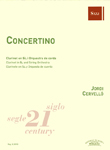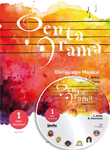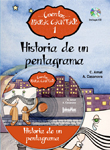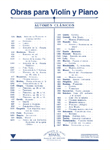Sardanes per a cobla (Vol. XI)
Cobla
FREIXAS, NarcisaReg.: B.4020
25,30 €
P.V.P. (VAT included 4%)
Add to cart
- Review: VELA, Ester; FIGARÓ, Jordi
- Ensemble: Cobla: With soloist(s).
Choir: With accompaniment; . - Genres: Classical / contemporary: Chamber.
Musical education: Instrumental study repertoire.
Folk music / traditional: Sardanas.
- Language: Catalán
- Product format: Partitura + particellas
- Difficulty level: Intermediate
- Period: 1st half S. XX
- Publishing house: Editorial Boileau
- Collection: Narcisa Freixas
- Illustrator: TORNÉ ESQUIUS, Pere
- No. of pages: 76
- Measure: 23,00 x 23,00 cm
- Lenght: 15'
- ISMN: 979-0-3503-4100-7
- Available in digital: No
- Available for rent: No
Cobla [flbl.2tipls.2tnres.2tpt.1tmb.2fisc.db]
The first work of Narcisa Freixas of which we have reference is the sardana La festa de les Roses, premiered in 1877 by the copla of Torroella de Montgrí in Castelló d'Empúries. This score is lost. The fact that it is precisely a sardana and not another type of work is significant, since it shows us the early interest in Catalan popular music and culture, which will be key in the production of the composer.
The three sardanas that are published in this edition -A Sant Medir, Dolça Catalunya and Flors de la terra- make up, lost the first one to which we have referred, the totality of the work for copla of the composer from Sabadell. They denote the author's appreciation for the popular vocal genre. All three are evocative and inspired, with traditional Catalan themes, rhythmically clear, using the usual rhythmic patterns of the time, late nineteenth and early twentieth century.
The instrumentation is rich, with varied and effective instrumental combinations. Both Flors de la terra and A Sant Medir are clear examples of choral sardanas. The lyrics were included in the publication of the piano version, the former with text by Dolors Monserdà and the latter anonymously, possibly by the composer herself.
The Dolça Catalunya has a symphonic concept with contrary melodic movements and an inspired tenora singing culminating in a modulation to the final tutti that stands out for the fiscornio's contracanto and in the background the second choral voices of the tenora and the trumpet.
Flors de la terra is the only one of which we know the date of premiere, 1914, the same year that he wrote the Himne a Catalunya, dedicated to Enric Prat de la Riba. It was first performed in a version for orchestra1 2.
In this edition have been reproduced as main source the manuscripts present in the archives of the copla Els Lluïsos de Taradell and of the Agrupació Cultural Folklòrica Barcelona; likewise have been consulted, as secondary sources, the piano reductions of the three sardanas appeared in the compilation Obras de Narcisa Freixas. Edition of Homage of 1928, which are the only reference as far as the sung part is concerned.
Jordi Figaró and Ester Vela
1. A Sant Medir
2. Dolça Catalunya
3. Flors de la terra










